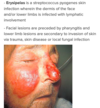10 - Streptococci Flashcards
(35 cards)
What are the shape of streptococci?
Gram positive cocci chains
String of pearls

How are streptococci classified into three groups by haemolysis?
- Alpha/Viridans (Green) : partial haemolysis
- Beta (White) : complete haemolysis
- Gamma: no haemolysis

What are Viridans streptococci?
- Alpha Haemolysis = partial haemolysis
- Mainly found in mouth
What else can streptococci be identified as apart from haemolysis?
- Lancefield
- Sherman group
What infection does strep pyogenes normally cause?
- Sore throat like tonsillitis and pharyngitis
- Can cause necrotising facitis
What shape and gram are staphylococcus?
- Clustered gram positive cocci
- Can be coagulase negative or positive

Identify and describe 3 virulence factors of streptococcus pyogenes.
- Streptolysin O and S: lysis of RBC, platelets, neutrophils
- Streptokinase: resolution of clots

What is the full name and classification of Strep.Pyogenes?
Lancefield Group A Beta-Haemolytic Streptococcus
What is streptococcal pharyngitis?
- Group A strep on throat swab
- Step.Pyogenes
- Untreated patients produced M protein antibody

What are some complications of streptococcal pharyngitis?
- Scarlet fever
- Rheumatic fever

What is scarlet fever?
Acute condition

What is acute rheumatic fever?
Causes inflammation of own tissues

What are some symptoms of rheumatic fever?

What is acute post-streptococcal glomerulonephritis?

What are some skin infections that Strep.Pyogenes can cause?
- Impetigo
- Erysipelas
- Cellulitis
- Necrotising fascitis
What is impetigo?
- Streptococcus pyogenes skin infection, often occurring in children of 2-5 years
- Initial skin colonisation, followed by intradermal inoculation
- Most common cause of glomerulonephritis

What is erysipelas?

What is cellulitis?

What is necrotising fascitis?
- Rapid extensive necrosis
- Severe pain before clinical changes
- Severe mortality so fast debridement and sweep test needed

What is toxic shock syndrome?

What is the pathogenesis of toxic shock syndrome?
- M protein-fibrinogen complexes bind to leukocytes that degranulate and release hydrolytic enzymes to break down endothelium
- Vascular leakage and hypercoagulability leading to hypotension, DIC and organ damage

What is the coagulase test?
Clotting means Staph Aureus

What is vegetation?
- Growth of bacteria on heart valve forming infected mass and leading to endocarditis
- Collection of fibrin, platelets and inflammatory cells

What is a biofilm?
Microbial communities attached to surfaces and encased in an extracellular matrix of microbial origin









